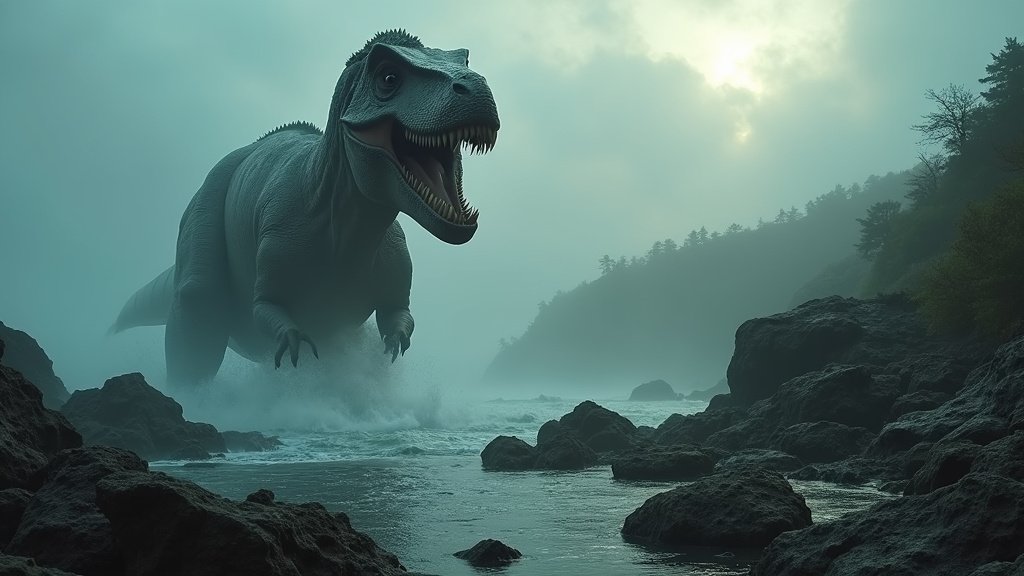A remarkable discovery has reshaped our understanding of prehistoric life in Britain, with scientists confirming the identification of a new species of large, flesh-eating dinosaur that roamed the ancient shores of Wales over 200 million years ago. Named Newtonsaurus cambrensis, this formidable predator lived during the Late Triassic period, shedding new light on the diversity and scale of early theropods, with the new fossil, Newtonsaurus cambrensis, filling a significant gap in our knowledge.
The Mystery of a Century-Old Fossil Solved: Unveiling Newtonsaurus cambrensis
For over 125 years, a fossil jawbone, unearthed in the late 19th century near Bridgend, Wales, remained an enigma. Initially described in 1899 by Edwin Tulley Newton as Zanclodon cambrensis, its true identity was debated, with some paleontologists questioning if it belonged to a dinosaur at all, or perhaps a crocodile relative. This specimen, consisting only of natural molds of the jawbone in rock as the original bone material has long since disappeared, sat in collections, including the National Museum of Wales, awaiting modern analytical techniques to unlock its secrets regarding this ancient carnivore.
Recent research, led by paleontologists Owain Evans and Professor Michael Benton from the University of Bristol, in collaboration with Cindy Howells from the National Museum Wales, has finally solved this ancient puzzle. By employing cutting-edge 3D digital reconstruction techniques, the team was able to create a highly detailed digital model of the jawbone. This advanced imaging allowed for an unprecedented study of its intricate features, including the placement of teeth and the texture of the bone, offering further insights into the Newtonsaurus dinosaur.
‘Newtonsaurus’: A Giant of the Late Triassic – The Newtonsaurus Dinosaur
The detailed analysis confirmed that the fossil belonged to a previously unknown species of theropod dinosaur. Theropods are a group of bipedal, carnivorous dinosaurs that include iconic species like Tyrannosaurus Rex and Velociraptor, and are ancestors to modern birds. Newtonsaurus cambrensis has been formally recognized as a distinct genus and species, named in honor of Edwin Tully Newton, the paleontologist who first studied it, contributing significantly to the understanding of the Newtonsaurus dinosaur.
Estimates based on the jawbone suggest that Newtonsaurus was a substantial predator, measuring between 5 to 7 meters (16 to 23 feet) in length. This made it one of the largest theropods known from the Triassic period, a time when most carnivorous dinosaurs were significantly smaller, typically less than 3 meters long. The sharp, serrated teeth preserved in the jaw indicate a diet of meat, and its robust build suggests it was an apex predator in its ecosystem, a true Late Triassic predator.
Unveiling Early Dinosaur Evolution with Newtonsaurus cambrensis
The discovery of Newtonsaurus cambrensis is particularly significant because it pushes back the timeline for the presence of large theropod dinosaurs. It suggests that these formidable carnivores were more widespread and diverse earlier than previously understood, reshaping scientific views on dinosaur evolution leading up to the mass extinction event at the end of the Triassic period. The animal’s placement near the origins of major theropod divisions, the Coelophysoidea and Averostra, makes it a crucial find for understanding how these lineages diverged, furthering our knowledge of the Newtonsaurus dinosaur.
Wales: A Trending Hub for Paleontological Exploration and the Newtonsaurus Dinosaur
This news continues to highlight Wales as a critical location for paleontological research. The Late Triassic rock formations in South Wales are rare globally, and they are proving to be a rich source of dinosaur discoveries, including this significant dinosaur discovery Wales. While Newtonsaurus represents a large carnivore, other finds, like the small theropod Pendraig milnerae, also discovered in Wales, offer a broader picture of the diverse life that inhabited the region millions of years ago, making the study of Newtonsaurus cambrensis even more vital.
Researchers emphasize that historical collections, like the Newtonsaurus jawbone, often hold secrets waiting to be uncovered through modern technology. The Victorians’ passion for collecting fossils has provided invaluable resources, and it is exciting to explore what other prehistoric wonders might still be hidden in museum drawers and geological sites across the UK. This ongoing exploration promises more fascinating news and insights for dinosaur enthusiasts to enjoy, with each new find, like the Newtonsaurus dinosaur, adding to the narrative.
A Glimpse into a Lost World: The Legacy of Newtonsaurus cambrensis
The identification of Newtonsaurus cambrensis is more than just the naming of a new dinosaur; it is a testament to scientific persistence and technological innovation. It allows us to explore a vital chapter in Earth’s history, revealing that even over 200 million years ago, Wales was home to impressive carnivorous giants, a true paleontology breakthrough. The discovery of Newtonsaurus cambrensis underscores the dynamic nature of prehistoric ecosystems and the constant evolution of our knowledge about them, making this a truly momentous piece of paleontological news about this flesh-eating dinosaur.





